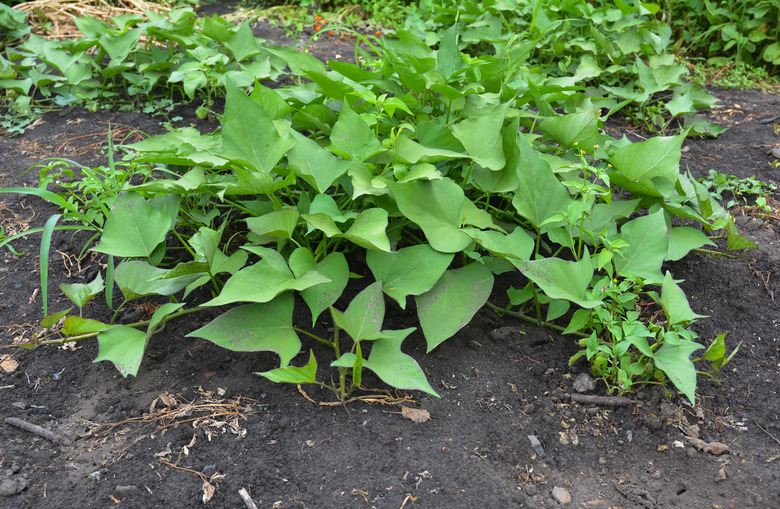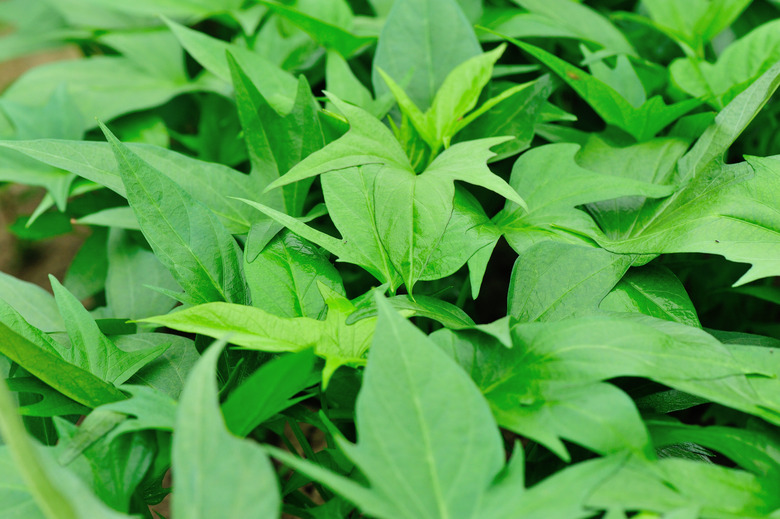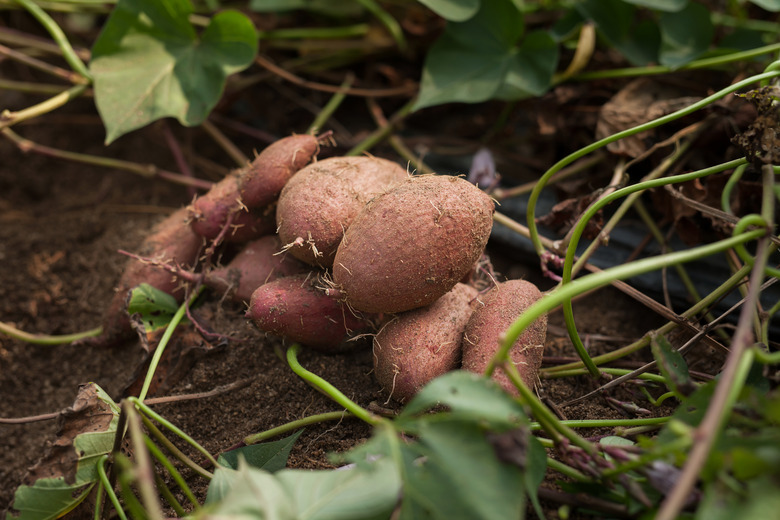How To Grow Sweet Potatoes
We may receive a commission on purchases made from links.
You might have guessed that the sweet potato (Ipomoea batatas) is a tropical, sun-loving crop. With its rich orange flesh and naturally sweet taste, sweet potatoes are one of nature's healthy comfort foods, so it's a shame to reserve them for holidays.
Planting your own can solve that problem, and you'll have to look hard to find a less-demanding crop. This root vegetable is a tender perennial in U.S. Department of Agriculture plant hardiness zones 9 through 11. It is, however, usually grown as a warm-season annual. It needs warm soil and lots of sun to grow, and with its needs met, it will be ready to harvest in 90 to 120 days.
Best Uses for Sweet Potatoes
Best Uses for Sweet Potatoes
Sweet potatoes are tender perennial plants that can grow for two or more seasons in warm climates like those in U.S. Department of Agriculture plant hardiness zones 9 through 11. Usually, they are grown as annual crops, but they are sometimes used for decoration in a landscape.
Sweet potatoes are related to morning glories, and their vines are lush and lovely, producing purple flowers in the summer. That means that in addition to eating, sweet potatoes can be used for ornamental purposes. Some people use sweet potato vines as quick-growing ground cover in the flower garden or backyard. These plants can also look nice in a hanging container on the patio.
However, most sweet potato vines are planted in the vegetable section of the garden, usually in mounds or ridges. The vines extend to cover the entire bed, with the edible tubers developing beneath the soil. They require a long, warm growing season before the sweet potatoes are ready for harvest.
How to Grow
How to Grow
Sweet potatoes aren't grown from seed. Rather, they must be grown from slips. These are sprouted from sweet potato roots. You can buy slips in garden stores, or you can grow your own. If you are just starting out, it may be better to buy certified slips to prevent various diseases that can infect slips. However, you can grow your own slips fairly easily from sweet potatoes from last year's garden or from organic sweet potatoes from the grocery store.
- Select a healthy sweet potato and put it inside the top of a large jar suspended by toothpicks.
- Fill the jar with water until the potato is half submerged.
- Sprouts should appear from the sweet potato in about two weeks, with one potato yielding about 12 to 20 slips.
- The sprouts will continue to grow from the sweet potato. Change the water when it gets cloudy.
- When the sprouts get to 6 inches long, they need to be separated from the mother tuber.
- Hold a sprout by the base and twist it to free it from the potato.
- The sprouts should now go into their own container of water. Put their bottom section in water to allow them to grow their own roots.
- In about 10 days, you will see the bottom sections rooting. At this point, the sprouts are called slips.
- Keep the slips in water or pot them to wait for transplanting into the garden.
Once all chance of frost has passed, the soil has warmed and the temperature at night stays at 50 degrees or higher, you can transplant the slips directly into the garden. Before you do, work the soil in the sweet potato bed to a depth of 8 to 10 inches. Make sure the soil is light and loamy. The plants prefer sandy soil.
Plant the slips 12 to 18 inches apart in rows that are at least 3 feet apart. Many gardeners plant them on a raised ridge or mound since this dries out quicker in spring than flat soil does, and it also warms up more quickly. You can spread black plastic mulch over the soil for a few days before planting to warm the soil if necessary. It should be about 65 degrees before transplanting. Don't forget that these vines need a lot of elbow room. Be sure to leave the recommended distance between rows.
In What Zone Do Sweet Potatoes Grow Best?
In What Zone Do Sweet Potatoes Grow Best?
Sweet potatoes can be grown as perennials in U.S. Department of Agriculture plant hardiness zones 9 through 11. However, they are almost always grown as warm-season annuals, and this is possible in all but the coldest zones. Their annual growing range includes USDA zones 3 through 11.
Gardeners hoping for a crop must also assess their warm-weather season to see if it is sufficiently long. To get a harvest of sweet potatoes, you'll need some three or four months (90 to 120 days) of warm weather between the last spring frost date and the first fall frost date. That explains why most sweet potatoes are cultivated in the Southern states.
When Should You Plant Sweet Potatoes?
When Should You Plant Sweet Potatoes?
Sweet potato slips should not be planted in the garden until all chance of frost has passed. Ideally, wait for three or four weeks after the final frost in spring if you have a sufficiently long growing season. It is also best to wait until the soil temperature is 65 degrees or above and night temperatures are at least 55 degrees.
Soil, Sunlight, and Water Recommendations for Sweet Potatoes
Soil, Sunlight, and Water Recommendations for Sweet Potatoes
Sweet potatoes like sandy, well-draining soil. The soil should be loose with lots of air space. This allows the sweet potato roots to get down into the soil and spread easily. It's important to loosen the soil to a depth of 12 inches before planting for best results. Clay soils or rocky soils will not make this plant happy or healthy since root room will be limited.
As far as sweet potatoes go, the more sun, the better. These plants appreciate hot days and warm nights. They are extremely heat tolerant and do best when the soil temperature stays above 55 degrees. Plant them in an area where the vines get full, direct sun for at least six hours a day.
Sweet potato vines need water to thrive and even to survive, especially as summer temperatures rise. The plants should get enough water so that the plants never wilt. You'll need to deeply water the plants weekly, getting the water to the top 6 inches of soil. You may need to water more often than once a week during hot, dry periods. However, limit extra water in the last part of the season to prevent skin cracking. For the last few weeks before harvest, keep water to a minimum.
How to Harvest Sweet Potatoes
How to Harvest Sweet Potatoes
It is best to harvest sweet potatoes when they grow to about 6 inches long and 2 inches in diameter. Start checking on your sweet potatoes when the maturity date arrives. This will be somewhere between 90 and 120 days depending on the variety. They are usually big enough to harvest when the foliage starts turning yellow.
It's easiest to use a spade fork to dig out the sweet potatoes. Cut away some of the vines and then use the fork to loosen the soil around the plant. Lift the primary crown of the sweet potato plant and then dig out the root vegetables with your hands.
Don't wash them yet or eat them. To get that sweet taste, you'll need to cure them before eating. Curing is a process of encouraging a second skin to form over scratches and bruises. All you need to do to cure is store the sweet potatoes in a warm spot of some 80 degrees and high humidity (about 90 percent) for 10 to 14 days. Don't let the potatoes touch each other. In a warm climate, you can use an outdoor table in the shade for curing.
Common Pests and Other Problems for Sweet Potatoes
Common Pests and Other Problems for Sweet Potatoes
The most common pests for sweet potato plants are root-knot nematodes, wireworms, and sweet potato weevils.
Root-knot nematodes are tiny worms that live in soil that can cause sweet potato vines to turn brown. Control them by testing the soil before planting and rotating to a nematode-resistant crop like sweet corn in alternate years. Using nematode-resistant varieties of sweet potato slips is also recommended.
Wireworms are the larvae of the common click beetle. They live in the soil and can attack root crops like potatoes, carrots, and sweet potatoes. Various insecticides have been shown to be effective against these pests.
Sweet potato weevils are the most serious pest of sweet potatoes. Control them by using slips that are free of weevils or treating the slips with insecticide. It also helps to keep the soil moist. Dry soil is prone to cracking, which allows the weevils to penetrate the area through the cracks. Sanitation is also important for weevil population management. Pick up and discard all leftover or damaged potatoes since they can support large populations of weevils.
Sweet potatoes do not like competition for nutrients or water. Start taking out weeds two weeks after planting and weed regularly to keep the beds clean. Be careful not to disturb the sweet potato plant roots. You can prevent root damage by being gentle during weed removal. Using mulch around the sweet potato plants is often effective to keep weeds out of the bed.
Common Diseases for Sweet Potatoes
Common Diseases for Sweet Potatoes
-
Scurf is
a fungus disease causing silvery, sunken blemishes on the sweet potatoes. This comes from slips produced from infected potatoes. The best method to prevent scurf is by investing in inspected slips for planting. -
Leaf spots appear as darkened spots on the leaves. This can be treated by spraying with neem oil.
-
Fungal leaf diseases are often caused by overhead watering of foliage and spacing plants too close. Water sweet potatoes early in the morning rather than late in the day. Use some type of drip system that doesn't spread water over the leaves instead of overhead hosing. It also helps to space the plants appropriately.


